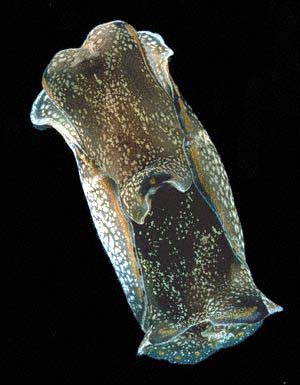
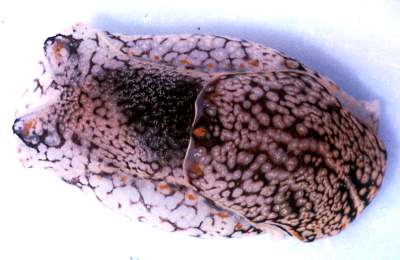
Philinopsis taronga
(Allan, 1933)
Order: CEPHALASPIDEA
Family: Aglajidae
DISTRIBUTION
South-eastern Australia [New South Wales, Victoria] and northern New Zealand.
PHOTO
Upper: Shelly Beach, Manly, Sydney, 2-3m, September 1982. Maximum length about 50mm. PHOTO: Bill Rudman.
Lower: in mud at low water, Ngataringa Bay, Waitemata Harbour, Auckland, New Zealand. March 1963. Photo: M.C. Miller.
The body is brown or blackish with scattered translucent whitish spots. There is considerable variation in colour pattern. In some animals the ranslucent spots have a central patch of opaque cream white or milky yellow, and sometimes the translucent spots can dominate the colour pattern reducing the brown background to a brown reticulation. There is a submarginal orange line, sometimes broken into spots, on the parapodia, and traces of a similar line along the edge of the posterior shield. There an also be a short orange line on the anterior sides of the head shield, and a few orange spots arranged symmetrically in the anterior midline of the head shield. There is usually a median white, or transluvent white line, or traces of such a line, running from the front of the headshield back along the midline of the head shield for some distance. The posterior edge of the headshield forms a raised pointd crest which has a central dark brown or black patch bearing a central orange spot.
This species has a "typical" foregut with a large partially eversible buccal bulb. (See Philinopsis cyanea and Philinopsis gardineri for discussion). It feeds on a wide variety of bubble shells, including Bulla and Haminoea in Australia and in New Zealand, Haminoea zelandiae, Philine auriformis, Melanochlamys cylindrica and the olive shell Baryspira. See message below discussing New Zealand colour form previously known as P. aureopunctata.
References:
• Burn, R.F. (1966): Some opisthobranchs from southern Queensland. J. Mal. Soc. Aust., 1: 96-109.
• Burn, R.F. (1969): A memorial report on the Tom Crawford collection of Victorian Opisthobranchia. J. Mal. Soc. Aust., 12: 64-106. (pl.4)
• Rudman, W.B. (1968) Three new species of the opisthobranch family Aglajidae from New Zealand. Transactions of the Royal Society of New Zealand (Zoology), 10(23): 211-216.
• Rudman,W.B., (1972). A comparative study of the genus Philinopsis Pease, 1860 (Aglajidae, Opisthobranchia). Pacific Science, 26: 381-399.
• Rudman,W.B., (1972). Structure and functioning of the gut in the Bullomorpha (Opisthobranchia). Journal of Natural History, 6: 547-560.
Rudman, W.B., 1998 (October 14) Philinopsis taronga (Allan, 1933). [In] Sea Slug Forum. Australian Museum, Sydney. Available from http://www.seaslugforum.net/find/philtaro
Related messages
Philinopsis taronga? from Tasmania
July 2, 2007
From: Patrick N Lewis
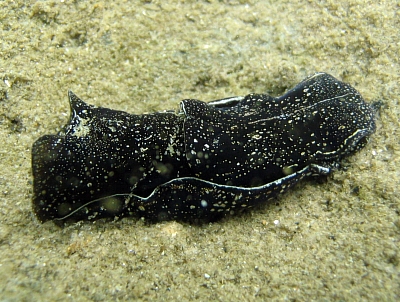

Could someone please confirm the identification of this species? It was photographed in shallow water in a sheltered bay in South-eastern Tasmania.
I have not observed the species previously but on a recent dive it was quite abundant. Individuals were moving about on the top of fine, silty sediments and one pair was observed to mate. Is it Philinopsis taronga?
Any further information of records of this species within Tasmanian waters would be appreciated.
Locality: Lauderdale, south-east Tasmania, 2m, Tasmania, Australia, inshore, 14 Febraury 2007, Shallow subtidal, silty sediments. Length: ~50mm. Photographer: Patrick N Lewis.
Regards
Pat Lewis
plewis@utas.edu.au
Lewis, P.N., 2007 (Jul 2) Philinopsis taronga? from Tasmania. [Message in] Sea Slug Forum. Australian Museum, Sydney. Available from http://www.seaslugforum.net/find/19478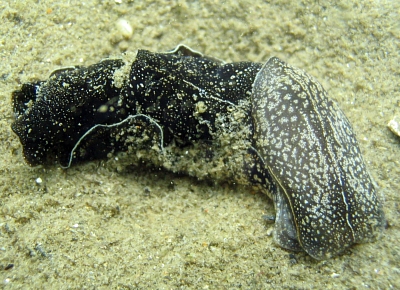
Dear Pat,
This is a nice series of photos showing Philinopsis taronga finding a partner and mating. In the second photo the darker animal has obviously sensed the mucus trail of the leading animal. The lower photo reminds me very much of the recent photo we have of Akera bullata mating in the Mediterranean [message #20050 ]. Although the two species are not closely related they have the primitive opisthobranch arrangement in which the penis is on the right side of the head while the rest of the genital apparatus opens on the back right side of the body. That is why in your photo the darker animal - acting as male - has climbed on to the leading animal on the right side so its penis (on the right side of the body) can be inserted into the female genital opening of that animal - which is acting as the female.
I am not sure of any records of this species from Tasmania. Although it can be relatively common at times, it is esentially a burrower in soft sediments, and has a frail internal shell, so it is not often seen either as a living animal or as a shell washed up on the beach. It is recorded from New South Wales, Victoria and South Australia in Australia, and also from New Zealand. It is not surprising it occurs in Tasmania, but I can't say if you have the first record or not.
Best wishes,
Bill Rudman
Shell of Philinopsis taronga from N.Z.
December 23, 2004
From: Bill Rudman

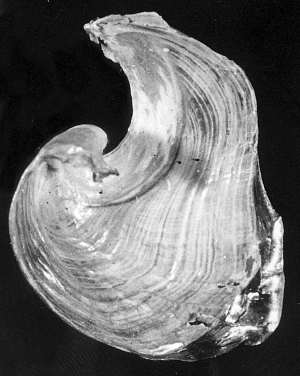
Here are photos of the shell of Philinopsis taronga. The shell in Philinopsis is much less calcified than the shell in Melanochlamys as illustrated in a separate message [message #12805 ]. In Philinopsis only a narrow band along the upper edge (in photo) is strongly calcified. [Note: in the animal, the shell sits with 'upper edge' facing posteriorly]. The rest of the 'shell' consists of a fragile, very thin, calcified layer over a corneous organic matrix.
The photographed shell is in fact from the paratype of Chelidonura aureopunctata Rudman, 1968 a very short-lived name I gave to new Zealand specimens of Philinopsis taronga. I synonymised the name within 3 years after realising that existing generic distinctions in the Aglajidae were wrong, and that the published anatomical description of Philinopsis taronga was incorrect. It was a very useful lesson for me, early in my career, in how essential it is to treat the printed word with caution.
PHOTOS: Paua Bay, Parengarenga Harbour, nthn New Zealand, 31 December 1966. Shell dimensions: 7 . 4 x 5.5 mm. [Paratype of Chelidonura aureopunctata ]. Photographer: G.W.Batt
-
Rudman, W.B. (1968) Three new species of the opisthobranch family Aglajidae from New Zealand. Transactions of the Royal Society of New Zealand (Zoology), 10(23): 211-216
-
Rudman, W.B. (1972) A comparative study of the genus Philinopsis Pease, 1860. (Aglajidae, Opisthobranchia). Pacific Science, 26(4): 381-99, 15 figs, 1 plate.
Best wishes,
Bill Rudman
Philinopsis taronga - life cycle information
December 9, 2003
From: Paul Furneaux

PHOTOS: Upper right, lower left - egg masses November 2003. Lower right - Phlinopsis taronga August 2003. Harbour Drive, Tauranga Harbour, New Zealand.
Dear Bill,
Earlier in the year my interest in sea slugs generally was sparked by finding some examples of Philinopsis taronga here in Tauranga Harbour NZ. Since then I have kept an eye out for them and have seen their numbers/activity decline during the winter months with only rare sightings of individual animals such as the example in the photo (taken in August). Reproductive activity seemed to come to a complete halt during July, August & September but in October I noticed that in a shallow (30-40cm deep) subtidal location adjacent to the tidal flats where I had observed them reproducing earlier in the year, egg masses were appearing. The average number per survey was about 35 egg masses and this number continued to increase within this sheltered subtidal area, but the egg masses also began to appear in the tidal streams that drain these flats and which drain into the subtidal area referred to. Furthermore, the number and range of these masses was far greater than anything that I had observed in autumn, reaching tallies of more than 250 egg masses (Dec 2nd). The photos show an example of an egg mass in water and a more typical pair of egg masses, partially exposed at low tide.
The animals themselves remained elusive, but they finally revealed themselves during a dawn survey when 16 individuals were sighted, (29th Nov.) possibly still active from their apparently nocturnal habit at this time of the year. It looks as if the numbers will continue to climb through the summer months and it will be interesting to follow their progress.
I'll be away for the next few weeks on holiday, so this will be my last communication for the year. Thanks very much for your help this year Bill, you and the Forum have been inspirational for me this year. All the best for the Xmas holidays,
Regards,
Paul Furneaux.
P.Furneaux@xtra.co.nz

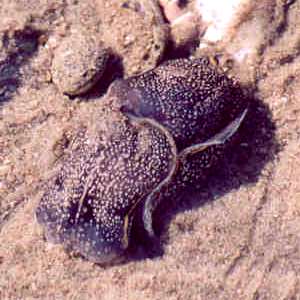
Thanks Paul,
Have a good holiday, and I hope in the new year you will have some time to discover a few more 'bubble shell' mysteries. Although some species are very common we know very little about their basic biology and life histories. You many messages from Tauranga, New Zealand, are certainly showing us all, that with diligence and perseverance, we can discover a lot in our own backyards
Best wishes
Bill Rudman
Philinopsis taronga in New Zealand
August 3, 2003
From: Paul Furneaux
Dear Bill,
My “old friend” Philinopsis taronga is still around [July 2003 - Tauranga, New Zealand] although its numbers have decreased and it is moving much more slowly in these colder winter temperatures. Its egg masses are still evident and I usually note around 3 to 5 individual animals on each visit, in the same area that I first came across them [see earlier messages].
Regards,
Paul Furneaux
P.Furneaux@xtra.co.nz
Furneaux, P., 2003 (Aug 3) Philinopsis taronga in New Zealand. [Message in] Sea Slug Forum. Australian Museum, Sydney. Available from http://www.seaslugforum.net/find/10636Thanks Paul,
It will be interesting to see if they disappear completely, and when the next generation start to appear
Best wishes,
Bill Rudman
Observations on Philinopsis taronga in NZ
June 3, 2003
From: Paul Furneaux
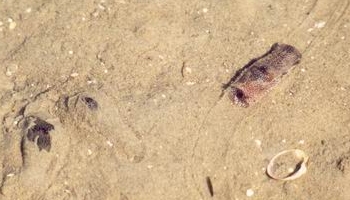
Hi Bill,
Thanks for all the information on Philinopsis taronga since my first message. Since I first came across Philinopsis (April 13th) I have been out on the mudflats in that same general area four times - 28th, 29th April, and 28th, 29th May. On all four occasions I counted several individuals of P. taronga; 11 individuals on April 28th, about 30 individuals on April 29th. The interesting thing about these individuals on both days is that they were mostly lighter in colour than the ones I photographed in mid April. The other interesting point was that they seemed to have been very busy reproducing and hopefully my photos will show this.
• 1. They seem to secrete a mucus wrap or envelope about themselves when they mate.
• 2. Their egg masses are large/long(4-6cm) and contain whitish coloured eggs.
• 3. The egg masses are anchored into the mud by "branches" of mucus at one end of the mass.
• 4. the egg masses are very often set out in pairs (one photo shows two animals depositing their egg masses) as though after mating they deposit their egg masses almost immediately.
• 5. I counted about 20 to 30 egg masses on April 28th and about 50 egg masses on April 29th. I found the egg masses over a much greater area than I did the animals themselves.
By May 28th and 29th the numbers of both the animals and the egg masses had fallen away to 4 and 7 animals and about 15 to 20 egg masses each day.
PHOTOS: Upper right: Showing 2 animals on left egg laying and another animal on right following mucus trail. Lower left: animal [on left] and egg mass [centre]. Lower right: Animals mating - upper 2 in mucus cocoons.
I must say that I never realized that "sea slugs" could be so interesting or exciting and I probably have to admit that I have "caught the bug". I spoke to a group of high school teachers recently about my work and extolled the virtues of the Sea Slug Forum, and as biology educators they are in a position to encourage young people to become involved in this sort of thing. Anyway I hope that the photos are useful, I'll send the other species over soon.
Regards,
Paul Furneaux.
P.Furneaux@xtra.co.nz
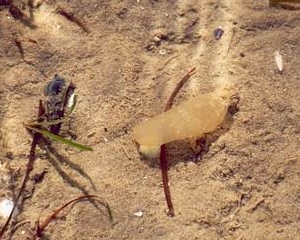
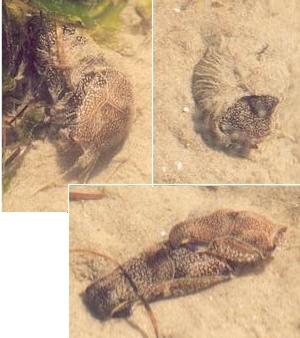
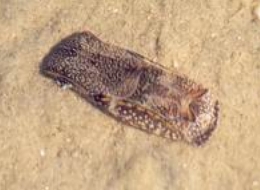
Thanks Paul,
P. taronga certainly seems a lot more abundant in Tauranga than it ever was in Auckland. Now that you have developed an 'eye' for seeing Philinopsis it will be interesting next year to see if you can find them at a much smaller size, perhaps a few months earlier in the year. The mucus 'cocoon' they form while mating is I think just a consequence of their design. There whole body is covered in microscopic hairs [cilia] which beat in rythym. At the front of the head are large mucus glands which secrete copious amounts of mucus most of the time. So when the slug is crawling along it is really being slid along through a tunnel of mucus ny these fine beating cilia. The mucus of course picks up the fine sand and silt particles which we can see in your photos makes the mucus 'tunnel' quite opaque. When the animal is not crawling along - such as when it is mating - the mucus is still being produced so the result is they mating pair end up in a big cocoon as you describe. As you desribe the egg masses are anchored in the sediment by long branched mucus filaments.
I am gad to hear than your later finds of Philinopsis have been lighter in colour. Seeing the yellow markings in the photo alongside certainly comfirms the identity of your animals. I look forward to further observations - and am glad you've 'caught the bug'.
Best wishes,
Bill Rudman
Re: Philinopsis taronga from Jervis Bay
May 30, 2003
From: Sue Newson
Hi Bill,
In regards to Philinopsis taronga and its parapodia lying flat out, could that be because it was moving at the time? It was moving towards the other opisthobranch, Euselenops luniceps. The significance of this didn't occur to me until later when I read that they ate other opisthobranchs.
Sue
snewson@shoal.net.au
Newson, S., 2003 (May 30) Re: Philinopsis taronga from Jervis Bay. [Message in] Sea Slug Forum. Australian Museum, Sydney. Available from http://www.seaslugforum.net/find/10084Dear Sue,
I am not sure why its parapodia were flattened. All aglajids normally have their parapodia close to their sides at all times. They have large mucus glands at the front of their head and when they are in muddy environments, the glands produce a tube of mucus through which they crawl. The fine particles of sediment stick to the mucus and so don't clog up the gills. If the parapodia are flattened out this mucus tube wouldn't work. It's possible the Philinopsis was following the trail of the Euselenops but I am not sure if it would try and eat it. You don't give any size information on the two animals so I can't really say if it would be physically possible. The Euselenops would need to be quite a bit smaller than the Philinopsis, because the Philinopsis feeds by ingesting whole animals. I don't know if species of Philinopsis eat pleurobranchs. I guess its possible. Normally they are reported to eat cephalaspidean bubble shells such as Bulla and Haminoea.
Best wishes,
Bill Rudman
Philinopsis taronga from Jervis Bay
May 26, 2003
From: Sue Newson
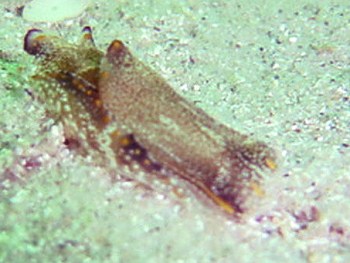
Hi Bill,
I was looking at your recent messages on Philinopsis taronga & thought you might like a photo of the one we find in Jervis Bay [New South Wales, Australia]. This photo was taken at a site called The Sandline Drop Off at a depth of 12m. 16 November 2002 at 3pm.
I found it on sand in a stingray 'outline'. It was about 20cm away from another species, Euselenops luniceps, which I have sent in a separate message.
Sue Newson
snewson@shoal.net.au
Newson, S., 2003 (May 26) Philinopsis taronga from Jervis Bay. [Message in] Sea Slug Forum. Australian Museum, Sydney. Available from http://www.seaslugforum.net/find/9991Thanks Sue,
Your photo shows the median white line and flanking yellow lines on the front of the headshield very well. I am not sure why it was sitting with its parapodia lying flattened out [what you describe as it 'stingray outline'], they are usually held against the sides of the body.
Best wishes,
Bill Rudman
Philinopsis taronga from New Zealand
May 23, 2003
From: Richard Willan
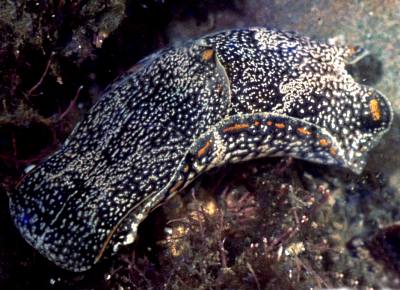
Dear Bill,
To add to the on-going discussion on Philinopsis taronga here is another example from New Zealand.
38mm, on surface of clean sand, ELWS level, Okoromai Bay, Shakespear Reserve, Whangaparoa Peninsula, East Coast, north of Auckland. 28 May 1979. Photo: R. C. Willan.
Richard Willan
Richard.Willan@nt.gov.au


Thanks Richard,
This is a nice intermediate between Michael Miller's photo in which there is a milky yellow patch in each translucent spot and Paul Furneaux's photo where there is not. This has been a particularly productive couple of weeks on the Forum. from a single photo, we now have a very good series showing the colour range in the species across its geographical range.
Best wishes,
Bill Rudman
Re: Philinopsis taronga from Victoria, Australia
May 17, 2003
From: Audrey Falconer


Here's a specimen of Philinopsis taronga from Portarlington (in Port Phillip Bay, Victoria [Australia]), 16 March 1997. I've never been able to work out which part of the animal is which in this photo, the way the animal is twisting turning. This is one of Leon Altoff's (my husband) first marine photos and he has improved since then! Unfortunately the slide is scratched and the water wasn't clean.
This is the only specimen we've photographed, and this is the only picture we have of it.
We've finished our field work for this year and will organise some pictures for the Forum in the next month or two. I suspect you'll be especially interested in Elysia furvicauda. I think it's the prettiest animal I've seen all summer. Are you also interested in some common slugs that aren't on the Forum? Spurilla macleayi, for example?
Audrey
audrey@bluering.org.au
Dear Audrey,
Thanks very much for this photo. I guess you have worked out the head end is at the top. Aglajids, especially the burrowing ones are very uncomfortable in flat smooth dishes. Since they spend much of their life buried in sand I guess they need the sensation of something pressing on them all over their body before they feel comfortable. My recent photos of Melanochlamys queritor show a similar 'uncomfortable' animal.
Leon's photo is very welcome as it shows an intermediate colour form between the New Zealand animals, with the brown reduced to a reticulate pattern, and the New South Wales animals where the brown is a dominant background colour. In this animal the front of the body and parts of the parapodia show the brown as a background colour while the rest show it as a reticulation.
Concerning your promise of future intersting photos. I certainly look forward to photos of Elysia furvacauda. I am interested in photos of even the most common nudibranchs from Victoria. Despite Bob Burn's excellent studies of the fauna, there are still very few published colour photos of Victorian opisthobranchs, and as we can see from other regions, a few photos showing variation are very valuable. I have done some collecting in Victoria, but short visits by intinerant collectors can never replace the work of residents who can sample a region regularly.
Best wishes,
Bill Rudman
Philinopsis taronga from New Zealand
May 16, 2003
From: Bill Rudman

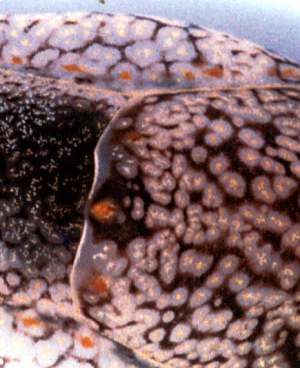
As promised in my reply to Paul Furneaux's message here is a photo, kindly provided by Michael C. Miller, of what I would consider the more common colour form of Philinopsis taronga in New Zealand. It represents the form I described as P. aureopunctata. In the lower close-up the creamy yellow spots in the translucent spots are clearly visible.
Data: in mud at low water, Ngataringa Bay, Waitemata Harbour, Auckland, New Zealand. March 1963. Photo: M.C. Miller.
In this form the brown pigmentation forms a reticulate pattern over a translucent clear background. There are usually clusters of creamy yellow spots in the translucent areas, but they can sometimes be absent. It matches the typical Australian colour form in having an orange spot in the crest on the posterior edge of the head shield, a submarginal row of orange spots along the parapodial edge, and a translucent clear median line on the head shield.
Best wishes,
Bill Rudman
Philinopsis taronga from Victoria, Australia
May 16, 2003
From: Bill Rudman

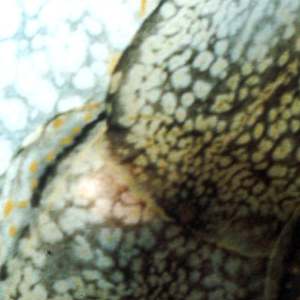
I hesitate to post this photo as the only information attached to it was 'Victoria', but it is the only illustration I have of an animal of Philinopsis taronga from that state. Of particular interest is the presence of yellow spots in the translucent white areas which match the colour pattern found in animals from northern New Zealand. If anyone has photos of animals from Victoria, or anywhere for that matter, they would be very welcome.
Best wishes
Bill Rudman
Philinopsis taronga? from New Zealand
May 13, 2003
From: Paul Furneaux
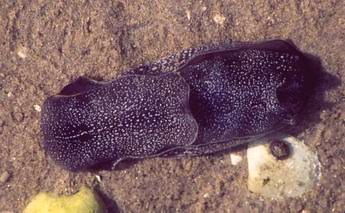
Dear Bill,
I am a high school biology teacher at Otumoetai College in Tauranga [East Coast, New Zealand] and I have a Science and Technology Fellowship for this year, in association with Waikato University and the Royal Society, to study Biodiversity in Softshores. As part of this project I have been photographing as many mudflat plants and animals as I can (with a view to making these readily available to schools etc). Recently I came across several bullomorph, sluglike animals that I had not seen here before.(I'm familiar with Haminoea zelandiae and Bulla (Quibulla), and this species is neither of these two - its shell is almost non-existent. Could it be a speckled version of Aglaja cylindrica? My main reference is Morton and Miller, The N.Z. Sea Shore and in there Aglaja is described as "jet black". I've included a couple photos, I hope that you can identify this animal for me,
Regards from,
Paul Furneaux.
P.Furneaux@xtra.co.nz
Furneaux, P., 2003 (May 13) Philinopsis taronga? from New Zealand. [Message in] Sea Slug Forum. Australian Museum, Sydney. Available from http://www.seaslugforum.net/find/9777Dear Paul,
This is an interesting find. Firstly it isn't Melanochlamys cylindrica [Melanochlamys is correct genus for this species], which is indeed jet black. I have just prepared a Fact Sheet for that species. It is normally found on rock platforms rather than soft sediments. Your animal is indeed an aglajid and I am pretty sure it is Philinopsis taronga. When I studied these animals in New Zealand many years ago I described a species quite like yours as Philinopsis aureopunctata (Rudman, 1968), but later came to the conclusion that it was the same as the southeastern Australian species P. taronga. In the New Zealand animals the transluent spots are usually much larger than Australian animals and so the brown background colour is redued to a brown retiulate pattern. Also in the centre of each translucent patch there is an irregular yellowish spot. Your animal is much darker than the specimens I am familiar with from New Zealand and lacks the yellow spots. I have checked my old notes and see that I did find a specimen at the mouth of the Wade River, just north of Auckland,, which had many small translucent spots and no yellow pigmentation, which matches your animal quite well. I hope to be able to post a photo I have of the more common NZ form soon, but am waiting for permission from the photographer.
I would be interested to know if you have found this animal often, and if so, whether it has any colour variations? Any sign of yellow spots perhaps? Species of Philinopsis feed on other bubble shells such as Haminoea and Bulla. Often they regurgitate the empty shells after digesting the animal. If you have photos of other bubble shells you would like to share with us they would be very welcome. Cephalaspidean bubble shells don't get photographed as often as their beautiful nudibranch cousins, and when I was a student in NZ I couldn't afford a camera to photograph them myself, so its a gap on the Forum that needs filling.
Best wishes,
Bill Rudman
Philinopsis taronga from Sydney (1)
May 13, 2003
From: Bill Rudman
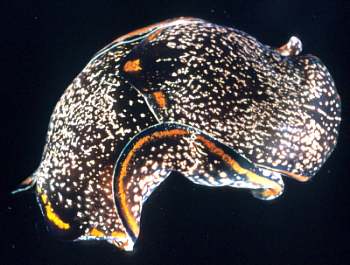

I am in the process of building up information on the aglajids on the Forum. Here is a record of Philinopsis taronga from Sydney.
Shelly Beach, Manly, Sydney, New South Wales, Australia. 4m on sandy bottom.
21 October 1979. 33mm long alive. AM C118092. Photo: John Fields.
Best wishes,
Bill Rudman
Philinopsis taronga from Sydney (2)
May 13, 2003
From: Bill Rudman
Here is another record of are some Philinopsis taronga from eastern Australia.
Shelly Beach, Manly, Sydney, NSW, Australia. 2-3m, 26 September 1982. Maximum length about 21mm. AM C135411. PHOTO: Bill Rudman.
Three empty shells of the bubble shell Tornatina apicina appeared in the bottle with this specimen after collection - either regurgitated or defecated. Shells 5,4,4mm long.
Best wishes,
Bill Rudman
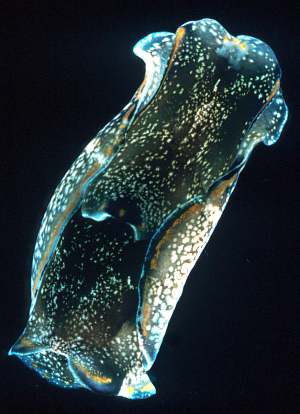
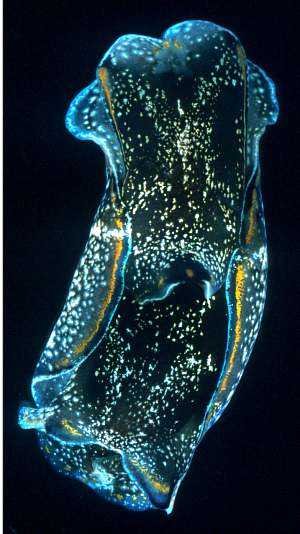
Philinopsis taronga from Port Stephens
May 13, 2003
From: Leanne & David Atkinson

Dear Bill,
Here is an animal that we originally thought was Philinopsis cyanea. After reading the messages about Philinopsis on the Forum we now think this is a Philinopsis depicta emerging from the sand. Both were taken at Fly Point, Port Stephens, New South Wales, Australia during daytime on the high tide in December 2001.
Regards,
Leanne & David Atkinson
atk@hunterlink.net.au
Atkinson, L. & D., 2003 (May 13) Philinopsis taronga from Port Stephens. [Message in] Sea Slug Forum. Australian Museum, Sydney. Available from http://www.seaslugforum.net/find/9924Dear Leanne & David,
The colour variation within species and the similarities between some of these species does have me wondering just how many species there are. In particular the Mediterranean P. depicta is very similar to the Indo-West Pacific P. cyanea. In this case however, your animal is P. taronga. I am adding some more information today on P. taronga and some related aglajids.
Best wishes,
Bill Rudman
